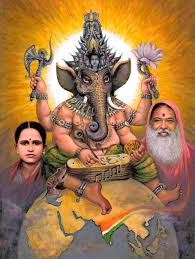Dharma should be protected with utmost compassion (daya). In the pretext of protecting dharma, it is wrong to get angry and impose harsh punishments for trivial faults. It is wrong to wage war for petty reasons. Peace is a very important pre-requisite for establishing dharma (righteousness). Hanuman preached Gavākṣa about peace.
Our dharma preaches that we should adhere to the ‘path of the elders’. This does not mean we should keep following the elders wherever they go. It means we should follow and practice the same rules of dharma (righteousness) as was practised by them. We should obey them.
Hanuman accepted Rama, who was a personification of dharma, as his Lord and completely surrendered to Him. Undergoing a lot of pain he went to Lanka in search of Sita. Seeing the pitiable state of Sita, his heart writhed in pain and in that moment of anger, he wanted to kill the demon Ravana. Yet recollecting his dharma, he stopped short of killing Ravana. He was careful not to transgress his limits as per the dharma. He wanted to meet Ravana in person and hence did all he could to reach Ravana’s court.
Hanuman was powerful enough to kill Ravana together with his entire troops. Yet, he spared him, as it would be against the rules of righteousness for him to kill Ravana. He knew that Lord Rama held dharma in the highest esteem. Hanuman did not want to do any act that would cause even the slightest pain to his Lord.
In Lanka, Hanuman was merely a messenger. It is wrong for a messenger to wage a war with the enemy. The messenger’s duty is to pass on his master’s message to the enemy in a peaceful manner. He can advice the enemy and try to resolve the dispute amicably. Hence, Hanuman tried to preach Ravana and sang the glories of His Lord Rama. Ravana paid a deaf ear. He followed the demonic dharma. Hanuman, in displaying his might at Lanka, actually showed the demons the power and might of Rama and of his army. He returned as successfully as he had gone. In addition, he assessed the power and capacity of Ravana and was able to give this valuable information to Rama. All of these are the traits of an efficient messenger.
Within all the deeds of Hanuman, his bhakta dharma (righteous duties of a disciple) and his dhoota dharma (righteous duties of a true messenger) are vividly visible. In Hanuman, many such dharma sookshmas (underlying subtle principles of dharma) are visible. The more we discuss about it, the more of such qualities we will find in him.
Vānara Mainda has praised Lord Hanuman as follows-
Samīra sute satatam tva dāgnaya tva damṣakha prerita manasendriyaha
Karo myaham ya chha śubhāśubham prabho tvat prītaye matkruta mastu tat sadā.
Meaning-
O son of the wind! I am Your partial incarnation. I am born due to you. My sense organ called mind is deeply influenced by Your orders. Therefore, let it be said that all the good and the bad deeds performed by me, are actions that have been performed by me out of love for you.
Mainda was one of the Sugriva’s ministers. He played a significant role and offered immense help in locating Sita. During the war against Ravana, along with Lakshmana, Mainda was also rendered unconscious.
Such a warrior Mainda, praised Hanuman in this strange manner. From his prayer, it is clear that he was born out of an aspect of Hanuman. Alternatively, perhaps pleased with his services (seva), Hanuman may have reminded him that he had a partial aspect of Hanuman in him.
Stating about himself, Hanuman openly declared that when seen from the body’s perspective (deha buddhi) he was a servant of Rama (Rama dāsa); from the conditioned soul’s perspective (jeeva buddhi) he was an aspect of Rama (Rama amsha) and from the Self’s perceptive (atma buddhi), he himself was Rama!
Mainda similarly, from the conditioned soul’s perspective (jeeva buddhi) declared that he was an aspect of Hanuman.
Om Namo Hanumate Namaha.
